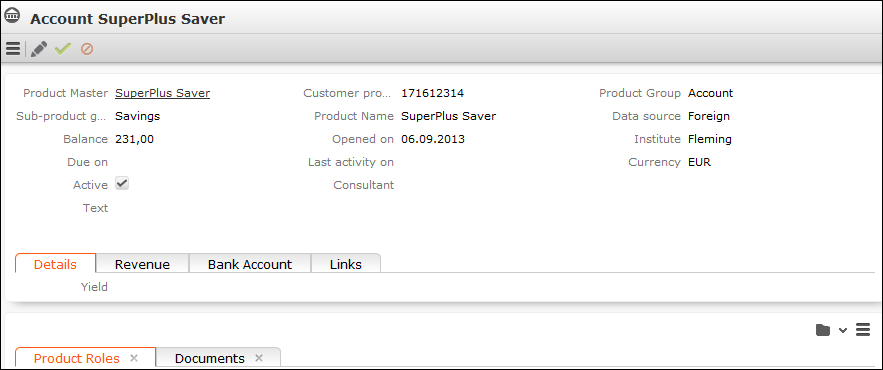Product Groups
Different types of products are assigned to different product groups (e.g. accounts, loans).
Product groups are also used to depict assets, real estate, contracts and bundles, which are handled in the same way as products.
The fields displayed on the mask depend on the product group.
Example: Account

Accounts
You can store information concerning customers’ accounts, e.g. revenue.
Loans
You can store information concerning loans, including the account number, due dates and term.
Building Savings Accounts
You can store information on building saving accounts, e.g. the beneficiary (as a role), term, type of savings and contractual amount.
Insurance Policies
You can store information concerning insurance policies, e.g. the term and insurance premium.
There are three types of insurance:
- Personal insurance
- Motor insurance
- Property insurance
Services
You can store information on services, e.g. standing orders, online banking and transactions.
Assets and Real Estate
You can store information on customer’s assets, e.g. patents, licenses or real estate property.
Securities and Security Accounts
You can store and manage securities and security accounts
- Securities
You can store information on securities, e.g. the purchase price, fees etc.
The following fields are transferred from the product master (see Product Master):
- Expenses %
- Expenses fixed
- Expenses minimum
- MiFID-specific fields, see MiFID.
You can combine several security titles stored for a company or person and group them in a securities account, see Assigning Securities to a Security Account. You can also manage securities independently from security accounts.
- Security Accounts
You can information on security accounts, e.g. revenue and fees.
All securities assigned to a security account are displayed on the Security tab.
Note: If you add a security to a security account, data entered for the security account on the MiFID tab is copied to the security. For further information contact your administrator.Assigning Securities to a Security Account
To assign a security to an existing security account:
- Switch to the desired security, see Product Overview.
- Click on
 (Select) to the right of
the Securities Account field on the
Links tab.
(Select) to the right of
the Securities Account field on the
Links tab. - Search for and select the desired security account.
A link to the securities account is entered in the Securities Account field.
Adding New Securities to a Security Account
To add a new security to a security account:
- Switch to the desired securities account, see Product Overview.
- Select New > New Security
Title or click on
 (New)
on the Security tab.
(New)
on the Security tab.The mask used to add securities is displayed, see Securities.
- MiFID
The MiFID tab in the Security and Securities Account info areas allow you to store risk profiles for securities and securities accounts in accordance with the EU financial markets directive MiFID.

The same tab is also available in the Product Master info area, see Product Master.
Compare the customer’s MiFID Risk threshold with the products’ MiFID Risk to ensure that a customer is only offered products whose MiFID Risk does not exceed the customer’s MiFID Risk threshold.